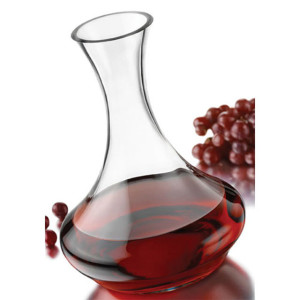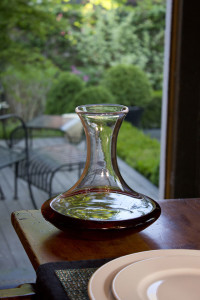Decanting wine is as old as wine itself. It’s original purpose was to get rid of solid matter in the wine. Pouring it carefully in a receptacle left any unsavory sediment in the bottle, amphora or barrel. Back in the day wines weren’t the clear and filtered beverages of today and getting rid of any unwanted bits before serving and consuming it was only normal.
Today the practice is a bit out of fashion. Wines are filtered and clarified before being bottled and don’t need any decanting. Or do they? It’s debatable but a double pour will enhance most reds. Leave the whites in their bottles.
Decanting reds serves two purposes. Firstly, in the case of aged wines, it gets rid of sediment. Secondly, it aerates the wine, enhancing its flavor.
Wines that have aged in a bottle for more than five years will always produce sediment. To avoid any gritty  substance leaving an unpleasant taste and texture you should decant an aged wine. Doing so isn’t hard but requires some effort. Before serving it you should put the bottle upright a day in advance so the sediment can sink to the bottom. When you’re ready to pour, take your bottle and place a source of light directly under the neck. Pour the wine slowly in the decanter and stop when you see sediment appearing in the neck of the bottle. You should have about a glass of wine left in the bottle which you can strain with a cheesecloth or strainer.
substance leaving an unpleasant taste and texture you should decant an aged wine. Doing so isn’t hard but requires some effort. Before serving it you should put the bottle upright a day in advance so the sediment can sink to the bottom. When you’re ready to pour, take your bottle and place a source of light directly under the neck. Pour the wine slowly in the decanter and stop when you see sediment appearing in the neck of the bottle. You should have about a glass of wine left in the bottle which you can strain with a cheesecloth or strainer.
Young wines today don’t have sediment but still benefit from decanting. Many young wines, especially heavily wooded ones, are bottled with dissolved gasses like nitrogen or carbon dioxide which close off the palate. The splashing effect of pouring them gets rid of those gasses and opens up the palate. The aeration process also softens strong tannins and allows for more complex flavors to develop. Some people even hyper-decant young wines by blitzing them in a blender for sixty seconds.
Aged wine benefits from aeration as well. They’ll often have a musky character to them that blows off when decanting.
Unfortunately there is such a thing as too much aeration. With delicate aged wines it’s recommended to decant them maximum thirty minutes before serving. Young wines can use some more time but it’s advisable not to leave them in a decanter for hours on end. There’s a lot of information online on how long you should let certain wines breathe but in the end it comes down to experimentation. And if you want to be on the safe side, don’t decant your wine too far in advance of serving it.
Decanting wine is definitely a thing you should do. Oxygen can do great things for young, old, cheap and expensive wines. It’s also the perfect excuse to splurge on a gorgeous, crystal decanter.
Cheers!
[Article by Alexander Eeckhout]



 0
0